CLEVELAND, Ohio — When quickly looking into the Latvian Cultural Garden from Martin Luther King Jr. Drive, a first glance may reveal a few boulders upon a hill with some rudimentary carvings.
But at a closer look, the arched sculpture, which is a granite boulder, represents the passage of immigrants from Latvia to the United States, from the old world to the new, through a silhouette of a woman in traditional folk dress.
According to Ilze Resnis, the co-founder of the Latvian Cultural Garden and president of the Latvian Garden Association, the Latvian garden was one of the first gardens that requested a spot in the gardens during its resurgence in the late ‘90s.
“One of our fearless leaders in the Latvian Association was named Silvija Rutenbergs,” Resnis says. “She would drive down to the forest [where the Latvian garden is now] and say, ‘Why shouldn’t we have a garden? The Estonians and the Lithuanians have a garden, we need a garden.’ ”
This is true. The Latvian Cultural Garden was dedicated in 2006. It was the second garden at the turn of the century, behind only the Indian Cultural Garden, which was dedicated a year before.
But the stones did not make their way to the garden until 2008 when they were shipped in from Latvia by sculptor Girts Burvis.
Aside from the arch, the other statues hold carvings. The two granite benches are reminiscent of a boat, and a “stream” rock symbolizes the many rivers, lakes, and the Baltic Sea in Latvia. Another rock sculpture with an inscription and encircled with a traditional Latvian “namejs” design was created by Gaits Burvis. The “namejs” is a popular design used in Latvian jewelry.
The first Latvian families thought to arrive in Cleveland came in the late 1800s, according to Cleveland Historical. But the first small wave that came to Cleveland occurred after World War I, says Resnis.
The population, like Latvia itself, was relatively small, numbering only 1,000 people in 1930. Latvia, area-wise, is about the size of West Virginia.
The second, larger immigration wave came after World War II. The previous independent Latvia, which sits in the Baltic Sea, was invaded by the Soviet Union in 1940, and Latvians became displaced.
“I myself was born in a displaced persons camp in Germany,” says Resnis. “People were looking for places to go and sponsors to sponsor them. I had an uncle who sponsored us, so we wound up in Akron, Ohio.”
Latvians who came in the first wave were essential to helping those coming because of the war adapt to the new country.
“They helped the new Latvians settle, helped them out with finding housing and furniture and whatever they needed,” Resnis says. “Then the community kept growing. People heard that there was a community in Cleveland and that the northern weather or atmosphere was more conducive to Latvia. So they gathered here in Cleveland, of course, because there were jobs.”
An estimated 2,500 Latvians had settled on the west side and in the suburbs by the end of the 1960s, according to Cleveland Historical.
Upon the resumption of Latvian independence in 1991, many Cleveland Latvians began revisiting their homeland.
Today, the number has grown to 3,433 people in Cuyahoga County, according to the newest census estimates, and Resnis says the Latvian immigration story is similar to many European immigration stories, even today.
“We’re very worried about the [Russians],” she says. “We don’t want the Ukrainian people to go through what we went through. We don’t want that to happen to any other country. People want their freedom, and they want to have their own religion and their own culture. You can’t find anything wrong with that.”







